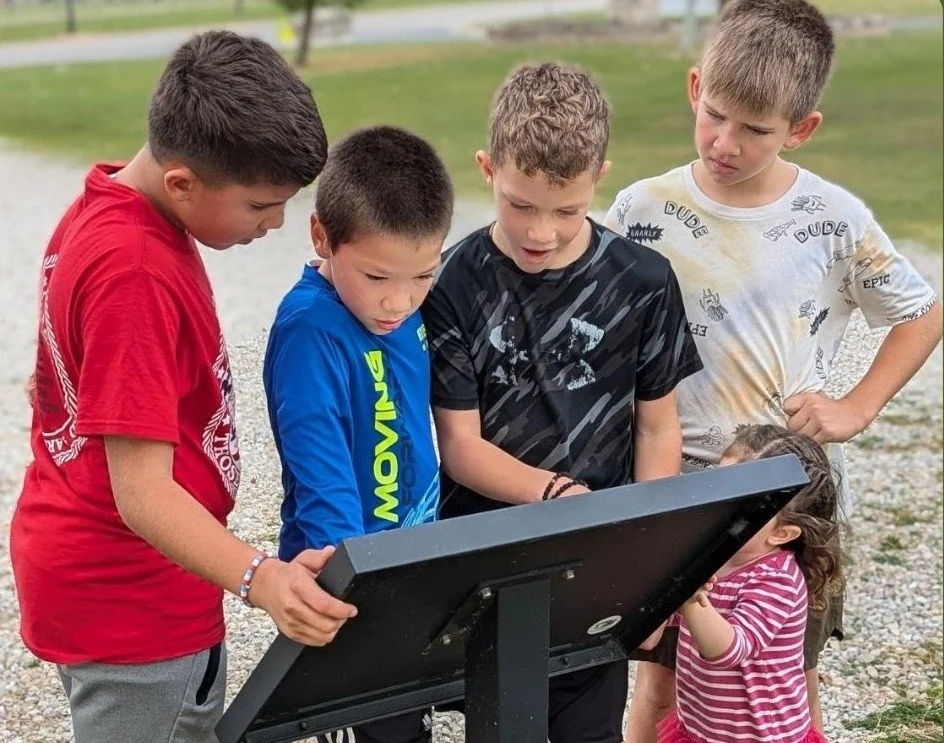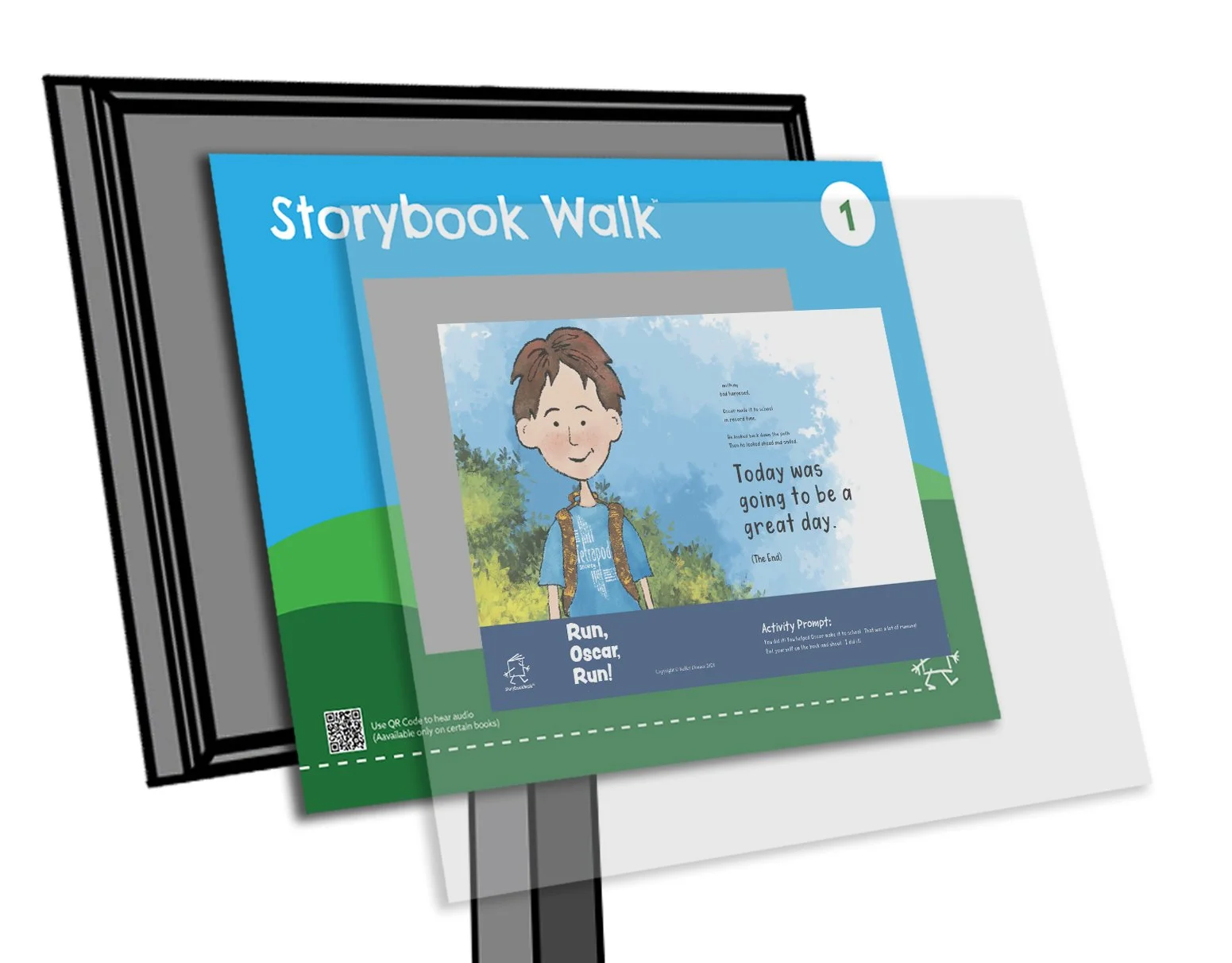The Storywalk® Revolution:
Facts, Figures, and New Innovations
Inspiring Literacy One Step at a Time
Although I am an author myself, I used to find reading challenging. I found it boring to just sit and read when I could be doing so many other things. So, the first time I stumbled upon a Storywalk®, I thought the idea was brilliant. There it was—a colorful sign with a book cover, inviting me to follow a trail and read a story. Finally, reading did not require sitting still. As I walked, I noticed families stopping at each panel and kids excitedly pointing to illustrations. This was not just a book—it was an experience. That moment made me realize how powerful StoryWalks can be in transforming the way we engage with stories.
According to the NEA, reading rates for both children and adults have been steadily declining since the pandemic, highlighting the need for innovative ways to engage readers. Even though research shows that early literacy is directly tied to future success, many kids struggle to engage with books. That is why Storywalks and other outdoor reading experiences are gaining traction in parks, libraries, and schools across the country. By turning reading into an adventure, Storywalks are changing the way communities approach literacy, one step at a time.
Storywalk Basics
The name StoryWalk comes from Anne Ferguson of Montpelier, VT who in partnership with the Kellogg-Hubbard Library started the Storywalk® Project in 2007 and registered the name. Designed to promote both physical activity and reading engagement, StoryWalks invite participants to follow a path while reading a book displayed page by page along a designated route.
A typical Storywalk exhibit with a metal frame, backer panel, story, and acrylic front sheet.
A typical outdoor reading installation involves a series of metal frames mounted on poles, positioned along a walking path. A standard frame usually contains either two sheets of acrylic or a sturdy backer panel and a sheet of acrylic. The pages of a book are normally laminated and placed between these two items. The cost of installing such a display varies, but together with backer panels and mounting materials usually range from $5,000 to $10,000. George Lesnak, the marketing coordinator for Pannier Graphics, the largest Storywalk frame manufacturer in the US, acknowledged this stating that they normally sell Storywalk exhibits in sets of 20. In addition, he added that one of the most popular trends are backer panels with various backgrounds and colors.
Interestingly, most story books do not fit into twenty frames. This is because most picture books are thirty-two pages long and feature only about twelve to fourteen spreads (facing pages). Including the cover and title page, a typical picture book requires fifteen frames to display an entire story. Nevertheless, these additional frames can be utilized creatively to include regional history, nature facts, quizzes, or additional information such as sponsors or instructions. At StorybookWalk.com, a premier provider of stories for outdoor reading experiences you will also find additional spreads like these to help you fill your empty frames. Their Ready-to-Use Storybook Walk Editions come in both size 11 x 17 and 18 x 24 depending on your preference and whether or not you use a decorative backer panel.
Not Just a Walk in a Park
Schools get creative with hanging stories. Here is School is More Than a Building: DIY Storybook Walk Edition from Kelley Donner on a fence at an elementary school.
While the original StoryWalk concept was simple—walk and read—today's walks have evolved into fully interactive experiences. Many now include activity prompts, discussion questions, and even hands-on stations that encourage deeper engagement with the story. Some installations have introduced audio components, allowing readers to listen to narration or sound effects as they move along the path. These enhancements make literacy walks more dynamic and engaging for participants of all ages. This past year in November, Let’s Move in Libraries along with the Association of Bookmobile and Outreach Services even hosted a Storywalk week. They received 43 submissions from libraries across the country wanting to share how they incorporated Storywalks into their programs.
These type of outdoor literacy initiatives began in public libraries and parks, but their reach has grown significantly. Envirosigns, a provider of StoryWalk frames, notes, “Our primary customers include libraries, schools, and parks, with public libraries making up a significant portion of our orders.” Schools are increasingly adopting them to promote literacy, outdoor learning, and movement-based education—a trend that accelerated during the pandemic as educators sought safe, engaging ways to encourage reading. Pannier Graphics has also observed this shift, noting that schools are becoming an increasingly significant part of the StoryWalk market. Barking Dog, another frame manufacturer agreed that Storywalks are branching out and that their customers “are truly creative in using their installations for literacy and learning of all types.” In addition, Main Street programs across the country have also embraced the idea, placing stories in storefront windows to create interactive reading trails in commercial districts.
A growing trend
The Mighty McKraken: Storybook Walk Edition in 18 × 24 from Izzy B in a Storywalk frame from Pannier Graphics on a nature trail.
Since their inception, outdoor literacy installations have experienced remarkable growth. According to research from Let’s Move in Libraries, only 300 public libraries in the U.S. and Canada offered outdoor StoryWalk programs in 2017. However, after the pandemic, libraries and parks across the country scrambled to find ways to engage children and adults in outdoor activities, leading to a surge in outdoor reading installations. Sales skyrocketed, and since 2020, demand has continued to grow as more communities recognize the benefits of combining literacy with physical activity. In 2024 alone, the top three outdoor story frame producers sold over 3,000 frames. Today, various reading displays can be found in every state in the US and across Canada, reflecting their increasing popularity.
As this trend continues, the possibilities for innovation are endless. With new technologies, interactive storytelling elements, and creative programming, outdoor reading displays are set to become a lasting feature in literacy education and community engagement. Whether in a public park, a schoolyard, or along a bustling Main Street, these immersive experiences are redefining how we connect with stories.
Kelley Donner
March 14, 2025
StoryWalk® is a registered service mark owned by Anne Ferguson of Montpelier, VT and was developed in collaboration with the Kellogg-Hubbard Library. StoryWalk® is used here for descriptive purposes only. StorybookWalk.com is not affiliated with or endorsed by the StoryWalk® Project.
Interested in creating your own StoryWalk? Explore ready-to-use Storybook Walk Editions and resources at StorybookWalk.com!





